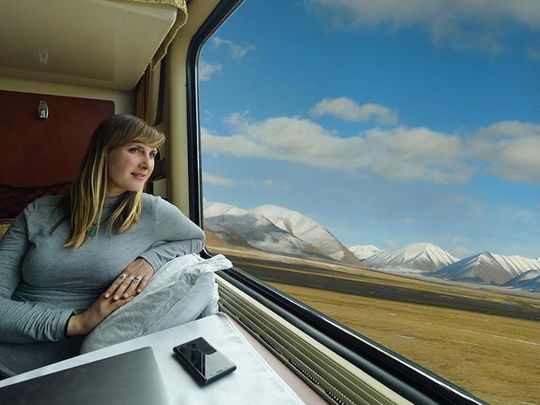
The first time I boarded a night train was in the late 1960s, when I was a teenager – 16 or so. I was travelling on my own, from Madrid to Paris, and was very excited.
I remember being shown to my personal compartment, which appeared on first impressions to be little more than a bench and a table, and then was invited by the attendant to dinner in the restaurant car.
The waiters wore white coats and bow ties, and were serving Spanish stew among other things. When I returned to my compartment it had been transformed into a cosy bedroom: crisp sheets, pillows, and a wash basin.
I was awoken in the night by a great clanking of machinery. As we crossed the border into France the bogies (the four or six-wheeled trucks that support the railway carriage) were being changed, as Spanish trains run on a broad gauge compared to the French standard gauge.
The changeover made quite the racket but I lay in my compartment, undisturbed. In the morning I walked out to find the restaurant car piled high with croissants and pain au chocolate, with waiters serving cafe creme. The train had changed nationality while I slept and acquired a new personality with it.

The allure of travelling by rail at night has never left me and hearteningly it seems night trains are making something of a comeback. Concern over the carbon emissions of short-haul flights is prompting a renaissance of the industry.
The French government, which previously cut its night train services to the bone, has just reopened its Paris to Nice service as part of a €100 million overhaul. More routes are on the way. Austria, meanwhile, has in the past few years successfully transformed the fortunes of its sleeper network, investing €200 million into its "Nightjet" trains. It is now possible to take a Nightjet between Berlin and Vienna, from Brussels to Munich, and Amsterdam – crossing between the great cities of Europe under the stars.
Britain, too, has seen recent investment in night trains. In 2019, the Caledonian sleeper – which runs between London Euston and the Scottish Highlands – unveiled its new £150 million fleet. The other sleeper service, the Night Riviera – which runs from London Paddington to Penzance – has also been refurbished and boasts a bar aboard its 1979-vintage British Rail Mk3 sleeper coaches.
These improvements were long overdue. The Caledonian Sleeper used to have no shower facilities and lavatories at the end of the corridor. Now, as I discovered when I recently travelled from London to Inverness, you can book a double bed with a bathroom attached, and eat haggis as the rugged Scottish countryside rolls by.
There is an excitement about night trains that has enthralled us throughout the mechanical age. Part of it is the sense of the world still thundering on while we slumber. WH Auden’s poem Night Mail describes a postal train charging north over the Scottish borders. "In the farm she passes no one wakes," he wrote, "But a jug in a bedroom gently shakes."
We also associate night trains with glamour. Marilyn Monroe on an old Pullman sleeper in Some Like It Hot and Agatha Christie’s Murder on the Orient Express spring to mind.
We associate them with luxury and mystery. People are thrown together capriciously on night trains. You don’t know who your fellow passengers are or their back stories. You don’t know whether they are villains or heroes. Even now when we board, we imagine there could be intrigue on the journey ahead...
I’m old enough to remember steam engines on regular services; I used to go to Scotland to visit my grandparents on them, and for holidays on the Isle of Wight. Later, under Margaret Thatcher’s government, I was promoted to minister for transport and played my part in saving one of our wonderful heritage lines – the Settle to Carlisle route, which traverses the Yorkshire Dales.
But I have become a particular aficionado of night trains over the past decade or so, broadcasting great railway journeys around the globe.
Recently I took a sleeper train through Ukraine – spending two long nights on carriages I would describe as workmanlike rather than luxurious, travelling from Kiev down to Odessa.
I also spent two nights on the sleeper service that runs from Ho Chi Minh city to Hanoi in Vietnam. That train is affectionately called the "Unification Express" because after the war the new government ensured the railway tracks were rebuilt so the warring north and south could be joined together.

As well as being highly symbolic, the train is used both by Vietnamese people and tourists. It also hosted a few too many cockroaches on board for my taste. But it served its purpose.
Contrast that with the likes of the Indian Pacific in Australia, which runs for 2,700 miles from Perth to Sydney, or the four-night Great Western Way, which runs between Vancouver and Toronto. These sleepers are essentially cruise ships on rails with all-inclusive food and drink, but their popularity keeps old train lines in existence.
To say we are re-entering a golden era of sleeper train travel is probably an exaggeration but certainly I expect to see their popularity grow. As well as being much more environmentally friendly than air travel, there is also added convenience.
It can be quite a rough experience travelling on a budget airline, waiting hours to go through security. Night trains convey you between cities so you can wake up refreshed in the heart of a metropolis. And I have always rested well on board - the rhythm lulls me into a deep sleep.
Ultimately, though, our sleeper services will probably never return to the utilitarian things they were in the past. They are expensive – a one-way ticket on the Caledonian sleeper costs £220 for a single bed – and they are a luxury in 2021; about pleasure, experience and enjoying a treat.
I saw this for myself just a few days ago standing on the platform of Fort William station, as the Caledonian Sleeper pulled in. A bespectacled man disembarked with a grin and breathed deep the air, telling me the trip was his 80th birthday treat. His excitement of having travelled through the night was infectious and one I wholeheartedly share.
And as for being awoken by the various mechanical clanks and whirrs, he had the simplest of solutions: removing his hearing aids and sleeping like a baby through the rattling, rolling night.
The Daily Telegraph










